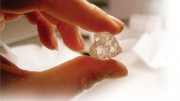At press time in mid-October, a feasibility study for Stornoway Diamond‘s (SWY-T) 100%-owned Renard project, in Quebec, was due out within weeks.
While Stornoway president and CEO Matt Manson said that capital costs would be higher than the $511-million (or $450 million in preproduction capex) outlined in an updated preliminary economic assessment from last March — reflecting industry-wide cost pressures — higher diamond prices mean revenues will also be healthier.
The previous study estimated an open-pit and underground mine at Renard would have a pretax net present value of $885 million ($538 million after taxes) and an internal rate of return of 24.8% (20.5% after taxes) over a 25-year mine life. A discount rate of 8% was used.
Those numbers were based on a September 2009 valuation of Renard diamonds at US$117 per carat and an exchange rate of $1.11 per U.S. dollar.
However, a re-valuation of Renard diamonds in July showed a 56% average rise in prices since 2009. The feasibility study, which will look at a 10 or 12-year mine life, will employ the new base-case valuation of US$182 per carat.
Once the feasibility is complete, Stornoway will also submit its environmental impact assessment to federal and provincial authorities, with public hearings expected to take place in the first half of next year. Once approved by both levels, the company would apply for final mine permits.
Manson said with construction expected to begin in mid-2013, assuming all permits are received and highway access is completed by that time, Renard could be in production starting in 2015.
The Quebec government is on schedule to start construction of a two-lane, gravel-road extension to Route 167, which will provide highway access to the project, by the end of this year. By mid-2013, the extension will be navigable from top to bottom (although not complete), and the company will be able to use it to bring construction materials and vehicles in.
Stornoway has agreed to contribute $44 million toward the road, beginning in July 2015 and amortized over 10 years. It will also kick in up to either $5,000 per km or $1.215 million per year for maintenance costs during the life of Renard.
The 243-km-long extension of Route 167 is part of Quebec’s $1.2-billion Plan Nord, which is designed to open up the province’s north for development. The government has set aside $331.6 million for the road.
The feasibility will assess the economics of the project using diesel-powered generators, however, an ongoing power line study by Hydro Quebec will look at building a 165-km line to the project from the LaForge hydro-electric power station to the north.
Although Stornoway doesn’t need a power line to start production, it would be an important element of a mine in the longer term since the company expects the mine life to be extended well past the decade or so that will be considered in the feasibility based on indicated resources.
“If you throw in the inferred resources, you’re up to twenty years plus,” Manson says. “The vision here is upwards of 40 years of mine life given the amount of ore we can reasonably imply is there. And all that material is within the scope of the shaft and the pits and the mine infrastructure that we’re building as part of the feasibility.”
The feasibility study on the power line, which would increase the capex of the project but significantly reduce power and operating costs over time, won’t be available in time to be included in the Renard feasibility.
As for financing in what have been extremely volatile markets since the summer, Manson said the company is fortunate that it doesn’t need to raise money right away since its construction target is not until mid-2013.
“We have the luxury of being able to sit on the sidelines and watch it all flow through,” he says. “Eventually, this market will settle down and people will be able to focus on building and growing and investing in things again.”
Manson says the company has strong backing from Agnico-Eagle Mines (AEM-T, AEM-N), which holds about 10.8% of its shares, and provincial agency Investissement Québec. (In a deal struck last year, Investissement Québec became a 37% holder of the company [25% of the company’s common shares, with the remainder consisting of non-voting shares] and gained the right to appoint three directors to Stornoway’s board in return for its 50% stake in Renard.)
The company doesn’t want to get involved in cutting and polishing or marketing Renard diamonds, but is otherwise “agnostic” as to how its product is sold.
“We will have to raise money to build our mine and we’re very sensitive about shareholder value and shareholder dilution,” Manson says. “If a marketing offtake agreement can be negotiated that provides a serious inflow of capital to the project, then we’ll seriously consider that.”
Renard hosts 26.6 million indicated tonnes grading 89 carats per hundred tonnes for 23.8 million carats and 31.1 million inferred tonnes at 56 carats per hundred tonnes for 17.5 million carats.
Stornoway is also paying heed to its pipeline, having recently generated two new grassroots projects: Pikoo, in Saskatchewan, and Aeon, in Quebec, which bears similarities to Renard.
“I don’t know how many companies you can count right now that are actually doing grassroots diamond exploration in Canada but. . . we’re one of them,” Manson says. “Even all the way through the credit crisis we had people out sampling and doing very discrete indicator mineral sampling on open ground and two of those projects have now borne fruit.”
Both projects will likely see drilling next year to follow up on airborne surveys and sampling programs completed this year.
In August, one of Stornoway’s founders, Eira Thomas, made a surprise announcement that she was leaving as a director and chairman of the company.
“It was a very personal decision on her part,” Manson says. “She wanted to move on to other things and pursue other interests. I don’t think it will have an impact on the direction of the company, but certainly we were sorry to see her go and we wish her all the best.”
Thomas was president and CEO of Stornoway until 2008. At presstime, there was no news on what she would do next. Anthony Walsh, president and CEO of Sabina Gold & Silver (SBB-T) and long-time director of Stornoway, has taken over as chairman.
In October, another of the company’s founders, Catherine McLeod-Seltzer resigned as Stornoway’s lead director.
Stornoway shares recently traded at $1.42 in a 52-week window of $1.36-2.96. The company has 118.6 million shares outstanding.





Be the first to comment on "Stornoway set to release Renard feasibility"